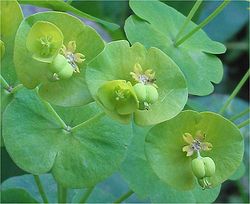
Wood Spurge
Encyclopedia
Euphorbia amygdaloides, the wood spurge, is a Europe
an plant in the genus Euphorbia.
It reproduces both from seeds and root runners that spread underground then sprout new plants. It often grows to a height of 80 cm, and has dark green leaves about 6 cm long. The complex green-yellow inflorescence (cyathium
) typical of Euphorbia appears between April and June. The milky latex
of the plant is toxic and it can cause irritation on contact with the skin.
Wood Spurge usually grows in the fertile and moist soil of the woodland
s.

Europe
Europe is, by convention, one of the world's seven continents. Comprising the westernmost peninsula of Eurasia, Europe is generally 'divided' from Asia to its east by the watershed divides of the Ural and Caucasus Mountains, the Ural River, the Caspian and Black Seas, and the waterways connecting...
an plant in the genus Euphorbia.
It reproduces both from seeds and root runners that spread underground then sprout new plants. It often grows to a height of 80 cm, and has dark green leaves about 6 cm long. The complex green-yellow inflorescence (cyathium
Cyathium
A cyathium is one of the specialised pseudanthia forming the inflorescence of plants in the genus Euphorbia . A cyathium consists of:...
) typical of Euphorbia appears between April and June. The milky latex
Latex
Latex is the stable dispersion of polymer microparticles in an aqueous medium. Latexes may be natural or synthetic.Latex as found in nature is a milky fluid found in 10% of all flowering plants . It is a complex emulsion consisting of proteins, alkaloids, starches, sugars, oils, tannins, resins,...
of the plant is toxic and it can cause irritation on contact with the skin.
Wood Spurge usually grows in the fertile and moist soil of the woodland
Woodland
Ecologically, a woodland is a low-density forest forming open habitats with plenty of sunlight and limited shade. Woodlands may support an understory of shrubs and herbaceous plants including grasses. Woodland may form a transition to shrubland under drier conditions or during early stages of...
s.


